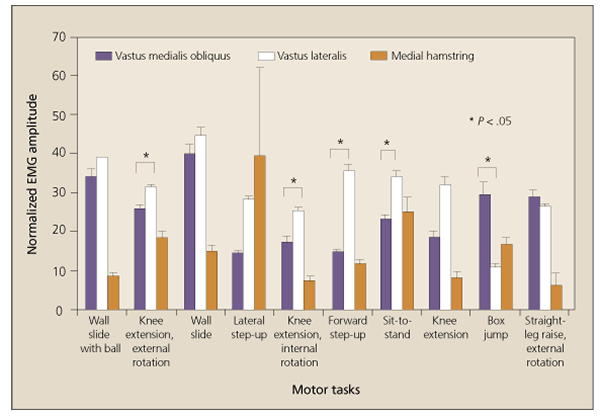Patellofemoral syndrome motor task interventions evaluated
We all know it well, and we have known about it since we were new grads: patients with anterior knee pain, worse with sitting and climbing stairs. It even has a nickname, “movie-goer’s knee.” The condition is patellofemoral syndrome.
We all know it well, and we have known about it since we were new grads: patients with anterior knee pain, worse with sitting and climbing stairs. It even has a nickname, “movie-goer’s knee.” The condition is patellofemoral syndrome.
Traditional therapeutic exercise interventions have included performance of various motor tasks designed to increase activity of the vastus medialis obliquus (VMO) in an attempt to equalize the pull on the patella. According to theory, motor tasks that enhance the VMO to vastus lateralis (VL) ratio can effectively activate and strengthen the VMO to create an appropriate balance between medial and lateral forces.
The problem physical therapists face is that many exercises are reputed to increase muscle activity in the VMO but there is little proof to support their effectiveness. At the College of Staten Island, we attempted to determine which exercises optimally activate the VMO by using surface electromyography (EMG) (BTS Bioengineering, Garbagnate Milanese, Italy).
We studied both open chain activities (with the patient’s feet free to move) and closed chain exercises (with the patient’s feet on the floor). The open chain exercises performed were long arc quads with external and internal rotation, lateral step-ups, forward step-ups, long arc quads (without rotation), and straight-leg raises with external rotation. Closed chain activities included wall slides with and without a ball and sit-to-stand. We also included a plyometric activity, the box jump.
Eight healthy participants (4 men, 4 women) performed 10 motor tasks that incorporated open chain, closed chain, and plyometric activities. Each motor task was repeated 6 times, and each repetition lasted about 3 or 1.5 seconds. Each burst of VMO, VL, and medial hamstring (MH) muscle activity was rectified (the absolute value of the raw signal was taken), and the area under the curve of the burst was measured and normalized to the maximal isometric contraction of each corresponding muscle. Descriptive statistics and 1-way analysis of variance were performed for each participant and across participants. For all test results, significance was accepted at P < .05.

Figure –Exercise interventions for patellofemoral syndrome have included performance of motor tasks to increase activity of the vastus medialis obliquus. Shown here is the overall amplitude of normalized electromyography (EMG) for muscles across 10 motor tasks.
The Figure shows the overall amplitude of normalized EMG for the 3 muscles (VMO, VL, and MH) across all 10 motor tasks. The box jump and lateral step-up motor tasks resulted in significantly greater activity in the VMO than in the VL in 37.5% and 25% of participants, respectively, suggesting that these 2 activities may recruit the VMO muscle fibers more than the VL. We found an inverse relationship between VMO and VL with long arc quads (88% of participants), long arc quads with external rotation (63%), long arc quads with internal rotation (63%), forward step-ups (63%), and sit-to-stand (50%); this result suggests that these specific motor tasks do not selectively recruit the VMO. The MH muscles play no role in patellofemoral syndrome but were studied because they are the antagonists of the quadriceps muscles.
A limitation of this study is that it was conducted in patients who did not have knee pathology. We suggest that a study of patients with patellofemoral syndrome would be worthwhile, including investigation of whether taping would have any effect on the performance of the motor task activities.